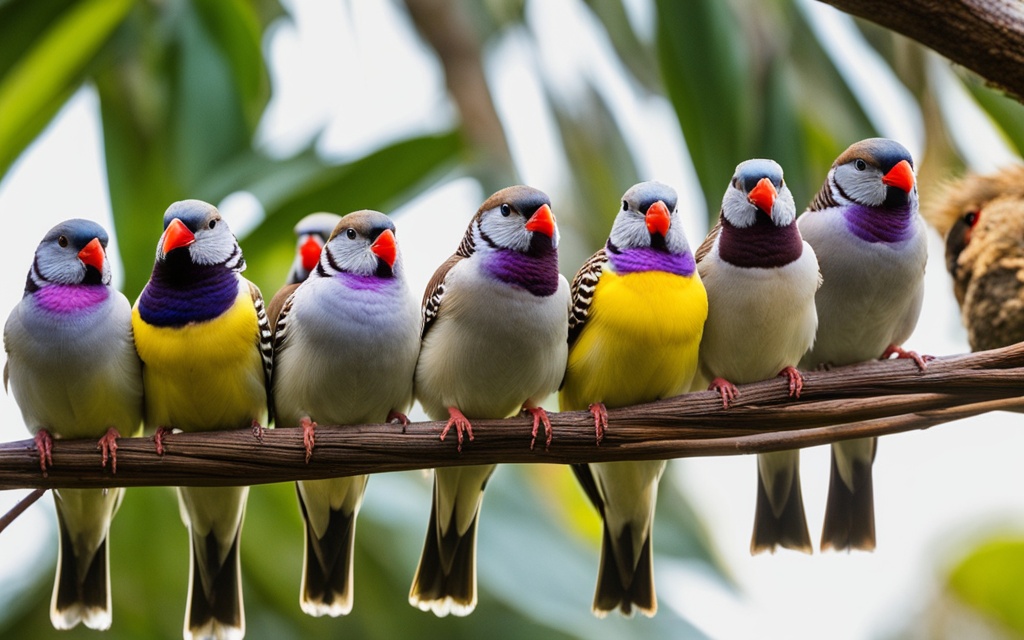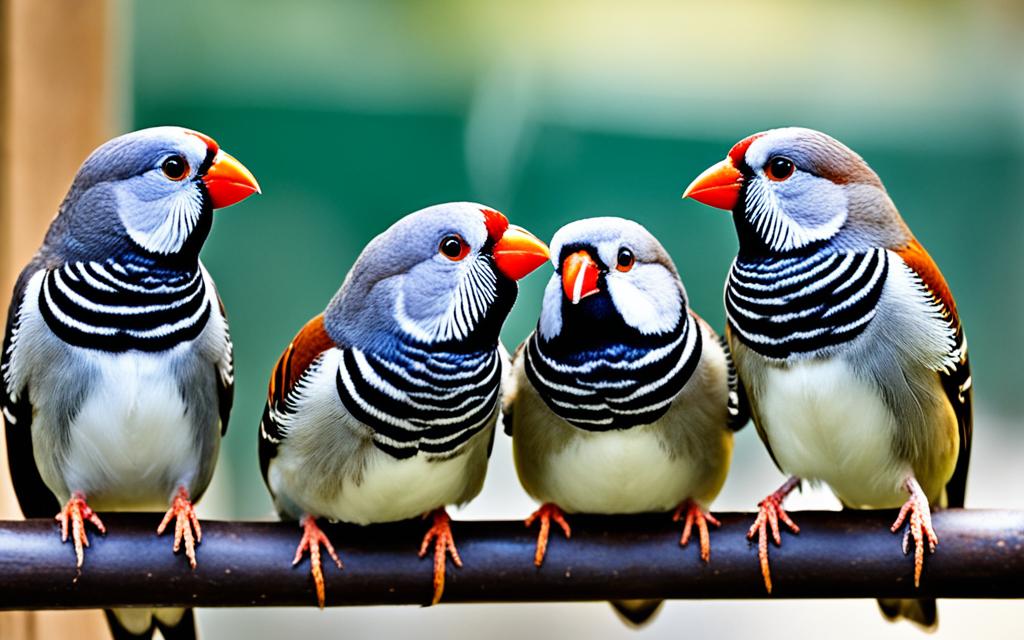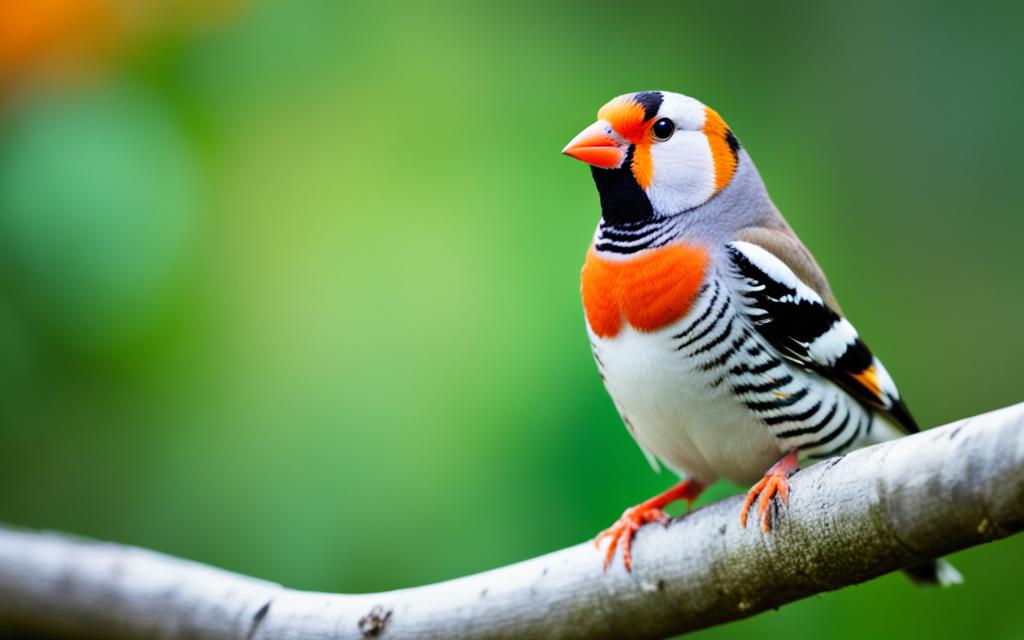As the renowned anthropologist Jane Goodall once said, “What you do makes a difference, and you have to decide what kind of difference you want to make.” This sentiment rings true when it comes to the captivating world of zebra finches, a species of small, seed-eating birds native to Australia. These delightful creatures, with their striking black and white plumage, have captured the hearts and imaginations of bird enthusiasts and aviculturists alike.
Belonging to the Estrildid finch family, zebra finches are among the most popular and well-studied aviary birds in the world. Their captivating appearance, engaging behaviors, and melodious vocalizations have made them beloved companions for those who appreciate the beauty and wonder of the avian kingdom. As the renowned ornithologist David Attenborough once observed, “The natural world is the greatest source of excitement; the greatest source of visual beauty; the greatest source of intellectual interest. It is the greatest source of so much in life that makes life worth living.”
Key Takeaways
- Zebra finches are a species of small, seed-eating birds native to Australia.
- These delightful creatures are known for their striking black and white plumage, which resembles the pattern of a zebra.
- Belonging to the Estrildid finch family, zebra finches are among the most popular and well-studied aviary birds in the world.
- Their captivating appearance, engaging behaviors, and melodious vocalizations have made them beloved companions for bird enthusiasts and aviculturists.
- Zebra finches are valued for their contribution to the diverse avian wildlife of Australia and their role as ambassadors for the Australasian avifauna.
Introduction to the Enchanting Zebra Finches
Belonging to the captivating Estrildid finch family, the zebra finch (Taeniopygia guttata) is a small, seed-eating bird native to the diverse landscapes of central Australia. These delightful creatures have captured the hearts of aviary enthusiasts and bird lovers worldwide with their striking black and white plumage, reminiscent of the distinctive pattern of a zebra.
Taxonomic Classification and Native Habitat
The zebra finch is a member of the Estrildidae family, a group of small, seed-eating birds commonly known as Estrildid finches. These finches are native to a wide range of habitats in Australia, including grasslands, savannas, and scrublands. Their adaptability and resilience have allowed them to thrive in the harsh, arid conditions of their native environment.
Physical Characteristics and Distinctive Markings
With their compact, rounded bodies and short, pointed beaks, zebra finches are easily identifiable among the small seed-eating birds of the Australasian region. The males are particularly striking, with their distinctive black and white plumage, accented by vibrant orange cheeks and a bright red beak. The females, while more subdued in coloration, are no less captivating, with a softer, more muted palette of browns and grays.
Zebra Finches: The Avian Ambassadors of Australia
Zebra finches have a long-standing cultural significance in their native Australia, where they are revered as symbols of resilience, adaptability, and the country’s diverse avian wildlife. These Australasian native birds are often depicted in Aboriginal artwork and serve as ambassadors for the unique avifauna of the region.
Cultural Significance and Symbolism
In the rich tapestry of Australian culture, the zebra finches hold a special place. These aviary birds are frequently featured in traditional Aboriginal paintings and carvings, representing the vibrant and resilient nature of the country’s native fauna. Their distinct black and white plumage patterns have become iconic, symbolizing the inherent beauty and diversity of Australia’s Zebra Finch breeding and Zebra Finch behavior.
Conservation Efforts and Threats
Despite their cultural significance, zebra finches face various threats to their populations, both in their native habitats and in captivity. Habitat loss, due to factors such as urbanization and agricultural expansion, has led to the decline of some Zebra Finch care populations in certain regions of Australia. Conservation efforts aim to protect the natural environments and ensure the continued survival of these beloved Australasian native birds.

Captivating Behaviors and Social Dynamics
The world of zebra finches, members of the Estrildid finch family, is filled with captivating behaviors and intricate social dynamics. These small, seed-eating birds native to Australia are known for their intricate courtship rituals and the strong, monogamous bonds they form with their mates.
Courtship Rituals and Monogamous Bonding
As Taeniopygia guttata, the scientific name for zebra finches, prepare to find a mate, the males engage in a series of elaborate courtship displays. The males will fluff out their distinctive black and white plumage, hop and dance in a mesmerizing fashion, and even perform unique vocalizations to attract potential partners. Once a pair is formed, zebra finches often remain together for life, demonstrating a remarkable level of monogamy among aviary birds.
Nesting and Breeding Habits
The nesting and breeding habits of zebra finches are equally captivating. These small seed-eating birds construct elaborate nests, often using a variety of materials such as grass, feathers, and cotton, to create a cozy and secure environment for their offspring. The female zebra finch typically lays a clutch of 4-8 eggs, which both parents take turns incubating and caring for the hatchlings. The Estrildid finches are known for their diligent parenting, with both the male and female actively participating in the feeding and protection of their young.
Zebra Finches: Beloved Aviary and Pet Birds
Due to their captivating appearance, engaging behaviors, and relatively small size, zebra finches have become immensely popular as both aviary and pet birds. These delightful Zebra Finches thrive in spacious, well-ventilated aviary enclosures that provide ample space for flight and perching.
Housing Requirements and Aviary Setup
Owners must ensure that the Zebra Finch aviary or cage is equipped with appropriate nesting materials, perches, and hiding spots to cater to the birds’ natural behaviors. Providing a variety of textures, such as natural branches and foliage, can enrich the Zebra Finch environment and encourage their instinctive nesting and roosting habits.
Dietary Needs and Feeding Guidelines
Zebra Finches are primarily seed-eaters, and their diet should consist of a high-quality Zebra Finch seed mix, supplemented with fresh fruits, vegetables, and occasional protein sources, such as mealworms or hard-boiled eggs. Maintaining a balanced and varied Zebra Finch diet is crucial for the birds’ overall health and well-being.

The Melodious Vocalizations of Zebra Finches
One of the most captivating aspects of Zebra Finches is their melodious vocalizations. These small seed-eating birds are known for their complex and diverse range of calls, which they use to communicate with one another and establish their territories. The males, in particular, are renowned for their intricate songs, which they use to attract mates and assert their dominance within the flock.
The Taeniopygia guttata, or Zebra Finch, is a remarkable vocalist, capable of producing a wide array of sounds that range from soft chirps to elaborate trills and whistles. These Aviary birds use their vocalizations to express a variety of emotions and behaviors, from courtship and territorial defense to social bonding and alarm calls.
“The songs of male Zebra Finches are incredibly complex, with each individual having a unique repertoire that can consist of up to 1,000 different syllables,” explains avian behaviorist Dr. Sarah Wilson. “These vocalizations play a crucial role in the species’ social dynamics and reproductive success.”
Researchers have discovered that Zebra Finch vocalizations are not merely random utterances, but rather a carefully structured system of communication. The birds’ songs are composed of distinct syllables and motifs, which they combine and rearrange to convey specific messages and establish their position within the flock hierarchy.
By understanding the intricacies of Zebra Finch vocalizations, scientists have gained valuable insights into the cognitive abilities and social dynamics of these small seed-eating birds. The study of their complex communication systems has also contributed to our broader understanding of avian behavior and the evolution of language in both human and non-human species.
Interesting Facts and Trivia
Beyond their captivating appearance and behaviors, Zebra Finches are known for their unique adaptations and the valuable contributions they have made to scientific research. These small, Estrildid finches native to Australasia have developed specialized physiological mechanisms to thrive in the harsh, arid environments of their native habitat.
Unique Adaptations and Survival Strategies
Zebra Finches (Taeniopygia guttata), like other small seed-eating birds, have adapted to conserve water and regulate their body temperature efficiently. Their kidneys are capable of producing highly concentrated urine, allowing them to minimize water loss in the dry Australian outback. Additionally, these Aviary birds can adjust their metabolic rate and body temperature to adapt to the extreme temperatures of their native environment.
Scientific Research and Contributions
Due to their small size, social behavior, and ease of study in captive settings, Zebra Finches have become a valuable model organism for scientific research. Researchers have utilized these Australasian native birds to gain insights into various fields, such as neurobiology, endocrinology, and animal behavior. The Zebra Finch’s complex vocalizations and song learning processes have been particularly well-studied, contributing to our understanding of avian communication and the neural mechanisms underlying vocal learning.
Zebra Finches: A Captivating Avian Companion
Zebra finches have become increasingly popular as pet birds, captivating the hearts of bird enthusiasts around the world. These small, social Zebra Finches can make delightful and rewarding companions, provided their specific needs are met. The pros of keeping Zebra Finches as pets include their vibrant plumage, engaging Zebra Finch behaviors, and relatively low maintenance requirements compared to some other bird species.
Pros and Cons of Keeping Zebra Finches as Pets
The vibrant black and white striped pattern of Zebra Finches is undoubtedly a major draw for many bird lovers. These Aviary birds are also known for their lively and social nature, often forming tight-knit pairs or small groups within the home. Additionally, Zebra Finches are generally easier to care for compared to larger or more demanding bird species, making them a popular choice for beginner or casual bird owners.
However, prospective Zebra Finch owners should also consider the potential cons of keeping these birds as pets. Proper Zebra Finch housing and Zebra Finch diet requirements, such as providing a spacious aviary, a varied seed-based diet, and regular socialization, are essential to the Zebra Finch’s overall health and well-being.
Responsible Ownership and Ethical Considerations
Responsible Zebra Finch ownership involves understanding the birds’ unique needs and committing to their long-term care. Prospective owners should research Zebra Finch care extensively, ensure they have the necessary resources and time to provide for the birds’ well-being, and prioritize the ethical treatment of these delicate Aviary birds.
By embracing the joys and responsibilities of Zebra Finch ownership, bird enthusiasts can foster a rewarding and enriching relationship with these captivating avian companions.
Conclusion
In conclusion, the zebra finch, a member of the Estrildid finch family, is a captivating and beloved avian species that has enchanted bird enthusiasts and researchers alike. These small, seed-eating birds native to Australia are renowned for their striking black and white plumage, engaging social behaviors, and melodious vocalizations.
As both aviary birds and cherished pets, zebra finches have captured the hearts of many, serving as ambassadors for the unique and diverse Australasian avifauna. Their breeding habits, behavioral traits, and care requirements have been the subject of extensive study, contributing to our understanding of these captivating creatures.
Whether marveling at their intricate courtship displays, listening to their enchanting songs, or simply admiring their striking appearance, it is clear that zebra finches hold a special place in the hearts and minds of bird enthusiasts around the world. As we continue to appreciate and learn from these feathered wonders, we can ensure that their legacy as Australasian ambassadors endures for generations to come.




